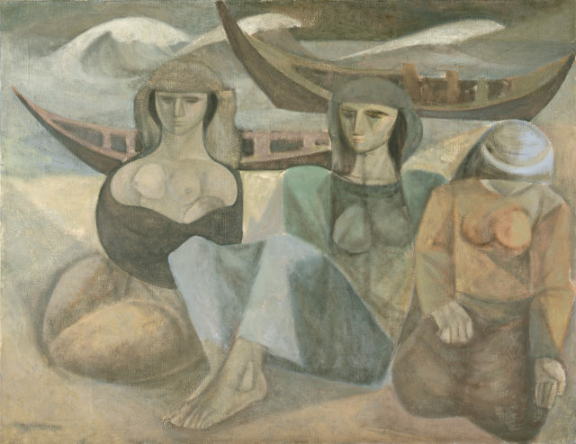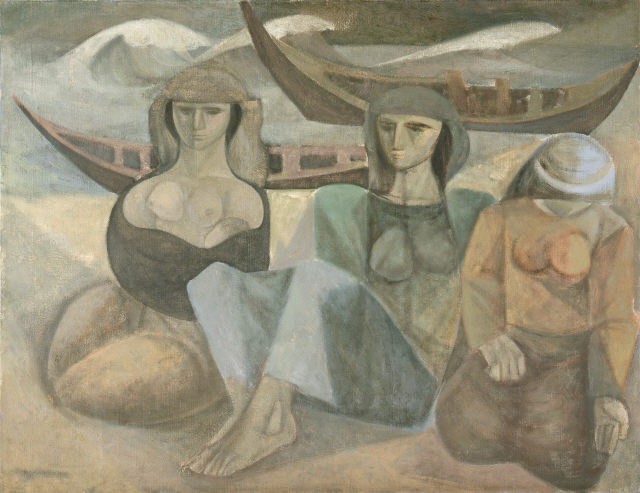
- 1950
- Canvas
- Oil
- Inv. 81P447
Júlio Pomar
Mulheres na Praia [Women at the Beach]
This work was produced in the neo-realist context which marked Portuguese culture since the end of the 1940's, of which Júlio Pomar (Lisbon, 1926) was a major exponent in the realm of painting. It was part of Pomar’s individual exhibitions in Lisbon (1950) and Oporto (1951), along with paintings such as Almoço do Trolha [The Bricklayer’s Lunch], Varina Comendo Melancia [Fishwife Eating Watermelon] and O Golo [The Goal]. Pomar’s neo-realism was informed by the theoretical contribution of the Portuguese painter and writer Mário Dionísio (1916-1993), who defended a “Marxist attitude” for the artist or cultural agent, as opposed to the strict aesthetic prescriptions as found in Soviet socialist realism. Against this background, his neo-realism matured as a painting of expressionistic influences, especially by van Gogh's post-impressionism, and much affected by Picasso's work after the “Return to Order” of the 1920's and 1930's, which crossed a cubist heritage with surrealism in the 30’s and 40’s. These influences were absorbed through reading and reproductions, as journeying abroad was for many of the young neo-realist generation, including Pomar, a then unachievable desire.
In 1953, and during a short period of time, Júlio Pomar committed himself even more to the reference of reality, working, at times, from photographs. These years are marked by the “Ciclo de Arroz” [Rice Cycle], an initiative of the writer Alves Redol (1911-1969) consisting in expeditions to the rice fields of central Portugal in order for the artists to attain a firsthand experience of the hardship of labor in the region. But it would be works such as this Women at the Beach that became the pictorial benchmark of neo-realism. The volumetric composition of geometric blocks, the insistence on the bare hands and feet, symbols of poverty and labor, the women's Spartan countenance, one of whom is using a shawl to wrap her baby close to her chest in a curious recording of an almost forgotten tradition – all resort, despite the heterodoxy of Portuguese neo-realism, to a set of recognizable aesthetic ideals. And one must not overlook the much closer and direct influence of the artist Almada Negreiros, who also admired Picasso and had already explored popular themes in ordered geometric compositions, notably in the recently completed frescoes of the Rocha Conde de Óbidos Maritime Station (1948).
MPS
November 2010
| Type | Value | Unit | Section |
| Height | 93,5 | cm | |
| Width | 122,5 | cm |
| Type | date |
| Type | signature |
| Type | Acquisition |
| Uma Arte do Povo, Pelo Povo e Para o Povo - Neo-Realismo e Artes Plásticas |
| Museu do Neo-Realismo |
| Curator: David Santos |
| 20 de Outubro de 2007 a 13 de Janeiro de 2008 Museu do Neo-Realismo, Vila Franca de Xira |
| Comissários: David Santos e Luísa Duarte Santos |
| A arte de pesca. As pescas e as artes |
| Museu Marítimo de Ílhavo |
| Curator: Museu Marítimo de Ílhavo |
| 01 de Março de 2005 a 01 de Novembro de 2005 Museu Maritimo de Ílhavo, sala de exposições temporárias |
| Exposição repartida por dois módulos com a duração de quatro meses, tendo por fim reunir um conjunto de obras relevantes que sejam testemunho da pluralidade das artes de pesca da "Costa de Aveiro" e do litoral português. |
| Pintura Portuguesa - Século XX |
| Câmara Municipal de Coimbra |
| Curator: Telo Morais |
| 6 de Dezembro de 2001 a 27 de Janeiro de 2002 Casa Municipal da Cultura, Coimbra |
| Exposição que pretendeu retratar a produção de alguns pos pintores mais relevantes do século XX. |
